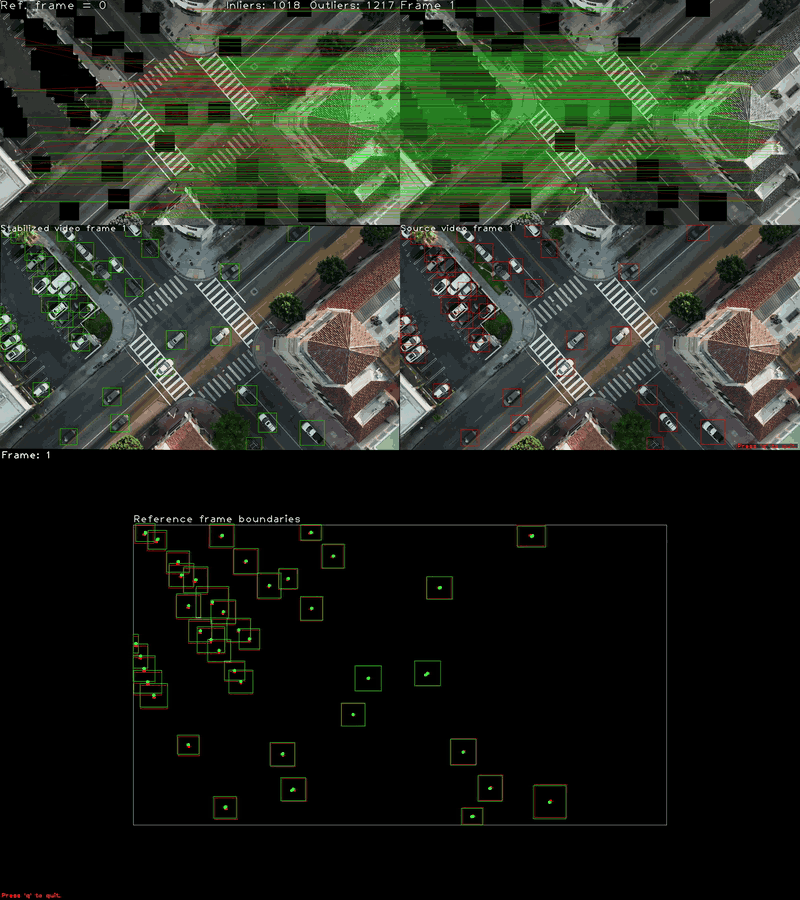Stabilo is a specialized Python package for stabilizing video frames or tracked object trajectories in videos, using robust homography or affine transformations. Its core functionality focuses on aligning each frame or object track to a chosen reference frame, enabling precise stabilization that mitigates disturbances like camera movements. Key features include robust keypoint-based image registration and the option to integrate user-defined masks, which exclude dynamic regions (e.g., moving objects) to enhance stabilization accuracy. Integrating seamlessly with object detection and tracking algorithms, Stabilo is ideal for high-precision applications like urban traffic monitoring, as demonstrated in the geo-trax 🚀 trajectory extraction framework. Extensive transformation and enhancement options, including multiple feature detectors and matchers, masking techniques, further expand its utility. The repository also includes valuable resources like utility scripts and example videos to demonstrate its capabilities.
- Video Stabilization: Align (warp) all video frames to a custom (anchor) reference frame using homography or affine transformations.
- Trajectory Stabilization: Transform object trajectories (e.g., bounding boxes) to a common fixed reference frame using homography or affine transformations.
- User-Defined Masks: Allow users to specify custom masks to exclude regions of interest during stabilization.
- Wide Range of Algorithms: Includes support for various feature detectors (ORB, (R)SIFT, BRISK, (A)KAZE), matchers (BF, FLANN), RANSAC algorithms (MAGSAC++, DEGENSAC, ...), transformation types, and pre-processing options.
- Customizable Parameters: Fine-tune the stabilization by adjusting parameters such as the number of keypoints, RANSAC parameters, matching thresholds, downsampling factors, etc..
- Visualization Tools: Generate visualizations of the stabilization process, with frame-by-frame comparisons and trajectory transformations (see the above animation).
- Threshold Analysis: Analyze the relationship between detection thresholds and keypoint counts for BRISK, KAZE, and AKAZE to fairly benchmark with different detectors.
- Benchmarking Campaigns: Use stabilo-optimize 🎯 to establish benchmarking campaigns to optimize algorithm and hyperparameter selection for specific applications.
🚀 Planned Enhancements
- Unit Tests: Comprehensive unit test suite to ensure package stability and reliability.
- Different Mask Types: Inclusion of additional mask types (e.g., polygonal, circular) for enhanced precision in stabilization.
- GPU Acceleration: Integration of GPU acceleration to improve processing speed.
- Documentation: Detailed documentation covering the package’s functionality and usage.
First, create a Python Virtual Environment (Python >= 3.9) using e.g., Miniconda3:
conda create -n stabilo python=3.9 -y
conda activate stabiloThen, install the stabilo library using one of the following options:
You can install the package from PyPI using pip:
pip install stabiloYou can install the package directly from the repository:
pip install git+https://github.com/rfonod/stabilo.gitYou can also clone the repository and install the package from the local source:
git clone https://github.com/rfonod/stabilo.git
cd stabilo
pip install .If you want the changes you make in the repo to be reflected in your install, use pip install -e . instead of pip install ..
from stabilo import Stabilizer
# Create an instance of the Stabilizer class with default parameters
stabilizer = Stabilizer()
# Set a reference frame with (optional) mask
stabilizer.set_ref_frame(ref_frame, ref_mask)
# Stabilize any frame with (optional) mask
stabilizer.stabilize(cur_frame, cur_mask)
# Get the stabilized (warped) frame
stabilized_frame = stabilizer.warp_cur_frame()
# Transform current masks (bounding boxes) if it was provided
stabilized_boxes = stabilizer.transform_cur_boxes()
# Transform any point (pixel coordinates) from the current frame to reference frame
cur_point = np.array([x, y, 1])
ref_point = stabilizer.get_cur_trans_matrix() @ cur_pointUtility scripts are provided to demonstrate the functionality of the Stabilo package. These scripts can be found in the scripts directory.
stabilize_video.py: Implements video stabilization relative to a reference frame.stabilize_boxes.py: Implements object trajectory stabilization relative to a reference frame.
find_threshold_models.py: Computes regression models between detection thresholds and average keypoint counts for BRISK, KAZE, and AKAZE feature detectors.
If you use this project in your academic research, commercial products, or any published material, please acknowledge its use by citing it.
- Preferred Citation: For research-related references, please cite the related paper once it is formally published. A preprint is currently available on arXiv:
@misc{fonod2024advanced,
title={Advanced computer vision for extracting georeferenced vehicle trajectories from drone imagery},
author={Robert Fonod and Haechan Cho and Hwasoo Yeo and Nikolas Geroliminis},
year={2024},
eprint={2411.02136},
archivePrefix={arXiv},
primaryClass={cs.CV},
url={https://arxiv.org/abs/2411.02136},
doi={https://doi.org/10.48550/arXiv.2411.02136}
}- Repository Citation: For direct use of the stabilo repository, please cite the software release version on Zenodo. You may refer to the DOI badge above for the correct version or use the BibTeX below:
@software{fonod2024stabilo,
author = {Fonod, Robert},
license = {MIT},
month = nov,
title = {Stabilo: A Comprehensive Python Library for Video and Trajectory Stabilization with User-Defined Masks},
url = {https://github.com/rfonod/stabilo},
doi = {10.5281/zenodo.12117092},
version = {1.0.0},
year = {2024}
}To ensure accurate and consistent citations, a CITATION.cff file is included in this repository. GitHub automatically generates a formatted citation from this file, accessible in the "Cite this repository" option at the top right of this page.
Please select the correct citation based on your use:
- Methodology: For referencing the research framework and methodology, cite the journal paper (or preprint if unpublished).
- Repository: For direct use of the code, cite the Zenodo release of this GitHub repository.
Contributions are welcome! If you encounter any issues or have suggestions for improvements, please open a GitHub Issue or submit a pull request. Your contributions are greatly appreciated!
This project is licensed under the MIT License, an OSI-approved open-source license, which allows for both academic and commercial use. By citing this project, you help support its development and acknowledge the effort that went into creating it. For more details, see the LICENSE file. Thank you!





